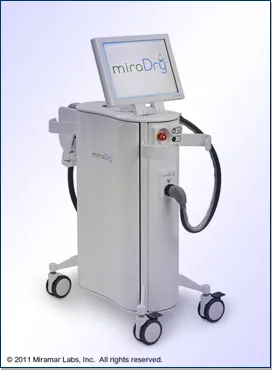- miraDry® - A Lasting Solution for Excessive Underarm Sweat
- Narrowband UVB Laser - Targeted light therapy for psoriasis and vitiligo
- Narrowband UVB Phototheraphy - Full body light treatment for psoriasis
- Secret RF - radiofrequency microneedling
- truSculpt ID - fat sculpting
- Tetra CO2 Cool Peel
Enjoy freedom from embarrassing underarm sweat
Are you bothered by your underarm sweat? Do you frequently apply antiperspirant? Are you frustrated over constantly ruining clothes? Are you worried about underarm sweat outbreaks?
Now, there is a lasting solution that can make embarrassing sweat a thing of the past.
Overview
Take control of your life with miraDry® - a non-invasive solution that provides lasting results
The miraDry® procedure is quick and non-invasive. The miraDry® System delivers precisely controlled energy to the region where the underarm sweat glands reside, and eliminates the sweat glands non-invasively. Because the sweat glands do not come back or regenerate after treatment, the results are lasting. And, results are fast – you can expect to see sweat reduction immediately after treatment, with minimal to no downtime.

The miraDry® procedure uses the only non-invasive technology that is FDA cleared and clinically proven to dramatically reduce sweat and provide lasting results. Now there is a lasting solution to sweat control that doesn’t use harsh chemicals, toxins or surgery.
Advantages of the miraDry® procedure
- Lasting results
- Dramatic reduction
- Immediate results
- Non-invasive
- Toxin-free
- Minimal to no downtime
- Quick in-office procedure performed by a medical doctor
Frequently Asked Questions
What is the miraDry® procedure?
The miraDry® procedure is quick, non-invasive and provides a lasting solution for excessive underarm sweat. The handpiece from the miraDry® System, when placed on the underarm, delivers precisely controlled energy to the region where the sweat glands reside and eliminates sweat glands non-invasively. The sweat glands don’t grow back once eliminated, resulting in a dramatic and lasting reduction of underarm sweat.
What is the procedure like?
The procedure involves no surgical incisions or cuts. The clinician customizes treatment for each underarm area with multiple placements of the miraDry® handpiece. Local anesthesia is administered to the underarms prior to the procedure to maintain comfort. Your office visit appointment will generally last an hour to an hour and a half. With our latest techniques often only one procedure is needed.
What happens after the procedure?
There is minimal to no downtime following the procedure. Your doctor will likely recommend a mild over-the-counter pain medication and use of ice packs for a few days. You should be able to return to normal activities or work right after the procedure, and you can typically resume exercise within several days. Some localized soreness or swelling is normal, and typically clears within a few weeks. Some patients have short-term altered sensation in the skin of their underarms or upper arms, which gradually disappears.

Most patients report a dramatic reduction of their sweat – in a recent clinical study1, the average sweat reduction was 82%. You should see a reduction in sweat immediately after treatment. As with any medical procedure, results will vary by person.
[1 Clinical study data on file at Miramar Labs, Inc.]
How long will the results last?
The results are lasting because the sweat glands do not come back or regenerate after they have been eliminated. The miraDry® procedure uses a safe, non-invasive technology that is FDA cleared to eliminate sweat glands in the underarm.
Don’t I need my underarm sweat glands?
Your body contains over 4 million sweat glands, with only about 2% located in the underarms. Eliminating this 2% will not affect the body’s ability to cool itself.
How is the miraDry® procedure different from other treatment options?
Other treatment options are designed to temporarily disable the sweat glands, or involve surgery which contains inherent risks. Only the miraDry® procedure provides a lasting solution with a non-invasive treatment.
Is the miraDry® procedure right for me?
If embarrassing underarm sweat outbreaks, stained clothing or frequent antiperspirant application interfere with your daily life, then you may be a good candidate for the miraDry®procedure.
Psoriasis / Light Therapy / Narrowband UVB Laser
What is psoriasis?
Psoriasis is a hereditary disorder characterized by itchy or painful thick, red, scaly patches of skin. It often affects the scalp, elbows, knees, groin, hands and feet, but may occur anywhere on the body. The disease goes through cycles, worsening for months or years and sometimes going into remission for a period of time. Typically, psoriasis begins in young adulthood, but may begin at any age. One percent of the population is affected. Psoriasis is not contagious. Multiple family members may be affected due to the hereditary nature of the disease.
What causes psoriasis?
There is much research dedicated to discovering the cause of psoriasis, but it is still unknown. It is thought that something in the environment triggers a genetically susceptible individual to develop psoriasis. Some people develop psoriasis after an infection, particularly with Streptococcal bacteria.
How is psoriasis treated?
New treatments for psoriasis are being developed every year, but there is no cure. Topical treatments include moisturizers, corticosteroids, Tazorac® (a vitamin A derivative), calcipotriene (a vitamin D derivative) Taclonex (a combination steroid and vitamin D cream). Some people benefit from light therapy (see below). Severe psoriasis may require therapy with oral medications such as acitretin (a vitamin A derivative), methotrexate (a chemotherapy agent), sulfasalizine (a sulfa medicine), cyclosporine (an immunosuppresant) or Otezla ( an inhibitor of phosphodiesterase 4). Other treatments use injectable biologic medications such as Enbrel, Humira, Stelara, Siliq, Cimzia, Cosentyx, Tremfya, Skyrizi and Sotyktu. These treatments are either given at the doctor's office, or are self injected using a device similar to an epipen.
A newer technology we have in our practice is the excimer Laser.
The excimer laser directs high dose narrow band UVB to hard to treat psoriasis plaques on elbows knees and scalp. Fewer treatments, some as quick as four minutes, can clear plaques without affecting surrounding skin. Most insurance plans do cover excimer treatments for psoriasis.
What is light therapy?
Ultraviolet light, in the form of natural sunlight or light administered in a special light box at the dermatologists office, has healing properties for many people with psoriasis. There are two types of controlled light available at Cary Dermatology: narrow-band UVB to the whole body in our light box or narrowband UVB to localized areas via the excimer laser. UVB is the type of light responsible for the tan people get outdoors. Narrow-band UVB is a very focused type of UVB that has been found to be more effective than standard UVB for controlling psoriasis.
How can Cary Dermatology help my psoriasis?
The physicians at Cary Dermatology are experienced in the diagnosis of psoriasis and in a wide variety of psoriasis treatments. We offer the latest narrow-band UVB treatment. We are active in the National Psoriasis Foundation and encourage patient membership.

